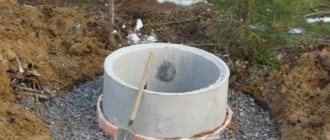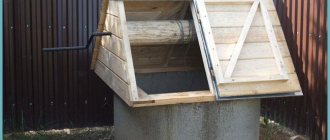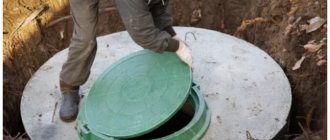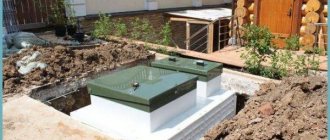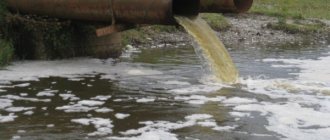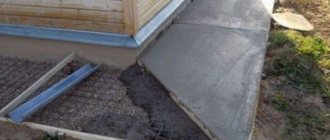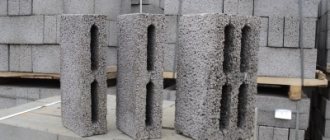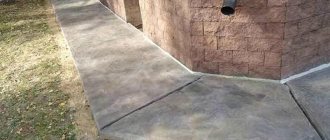Today, not every person can afford to have their own well, because this requires a certain area of land and many more additions. In this article we will look at what exactly is needed to build this treasure of water, the stages of its construction, safety precautions and much more.
Wells have the following advantages of their content:
- They always provide water , and are needed in those areas where there are interruptions in water and electricity.
- They are not very expensive and require minimal maintenance.
- They serve for a very long time. Usually they are buried only when the water sources drop very low, which can happen after at least forty years.
- They provide tasty and clean water if built correctly.
- Compared to wells and wells, they are very cheap.
The disadvantages are:
- There is a high risk of water pollution , which may be due to poor ecology and also due to foreign objects getting inside the well.
- Old pipes may taste rusty.
- If wells are not used for their intended purpose for several years , then their bottoms will become silted, so they will need to be cleaned.
- A small amount of water can be collected at a time (except when the owner installs a pumping system).
- If this is the only source of water , then it will obviously not be enough to water the garden, garden, flower beds or water supply to the pool.
Device
Well construction
The sewer well has the following features of its design:
- It should be located as far as possible from a regular well.
- Externally, such drain structures have a round or square shape , the bottom of which is filled with concrete.
- When building them, it is very important to make the walls and bottom airtight so that dirty wastewater does not enter the soil.
- They need to be cleaned with suction pumps.
- Typically, such structures are made of brick or concrete rings.
The pipeline, which is intended to be used all year round, should be installed with a slight slope towards the well. This is necessary so that water can be quickly drained from the system when interruptions occur.
A ventilation drain is needed to remove gases and unpleasant odors from the mine that will accumulate in it. It’s better to do several of them at once.
The installation of the power supply system and piping must be done on three-conductor copper cable with rope for outdoor use.
According to the standards, pipes must have the following dimensions in their design:
- For pipelines with a diameter of up to 140 mm - no less than 70 mm.
- On pipes up to 600 mm – 1000 mm.
- On pipes with 700 mm - 1250 mm.
- On pipes from 1000 mm - 15000 mm.
Briefly about the occurrence of groundwater
The average depth of aquifers is from 4 to 30 m. The layers that are closer to the surface are called perched water. Water is sometimes extracted from them for technical and economic needs. The flow rate is not always sufficient and constant throughout the year. The main source of replenishment is precipitation, which is not sufficiently purified by the soil.
Between the perched water and the layer with drinking water there are several layers. They are permeable and impenetrable. The first ones freely pass and filter water and consist of sand, pebbles, crushed stone, and gravel.
Waterproof layers are clay and loamy masses, rocky rocks without cracks that prevent the penetration of dirty runoff. Moisture condenses between 2 such waterproof layers. When the top layer is opened, the water level rises, sometimes it flows like a fountain. The flow rate is constant regardless of the time of year.
Kinds
Wells come in the following types:
Concrete
They are round shafts into which concrete rings are inserted. They are very popular and do not require much effort to build.
Wooden
They are more ancient and were used in old villages. The advantage of such structures is that they provide clean water. The downside is that they are not as durable as concrete ones.
Mine
These structures, when constructed correctly, provide good water and last a long time. The depth of the mine well is usually small - from 3 to 15 meters.
Tubular or drill
It is a well that has a water filter and a pump. Also, special pipes with filters are lowered into this well and everything is hermetically sealed to prevent air from entering when the electric pump is operating. If all components are well installed, such a structure can function properly for decades.
How to seal seams: mine waterproofing
When the well is completely drilled and the rings are all in place, they need to be waterproofed from the inside.
If it will be carried out in wet soils, then coating compounds are recommended. For example, you can use bitumen mastic. She must treat the outside of the rings. This will significantly extend their service life. The joints are additionally coated from the inside.
Concrete shafts are often wrapped with roll insulation, such as dense polyethylene, as waterproofing. Film is much cheaper. However, it is used exclusively from the outside. You need to quickly dig around the rings in a circle and wrap them with film.
Important ! The film will last for several years if you buy a durable one with reinforcement. But it is better to allocate a budget for coating insulation.
Some summer residents resort to additional waterproofing by making a clay castle. This is especially true if clay rises to the surface when digging. It can be used by filling the well from the outside.
Selecting a location
When choosing a place to build this structure, you should be guided by the following recommendations, since the quality of future water depends on it:
- You need to dig it as far as possible from sewers , toilets and sources of household pollution that enter the ground. The minimum distance from such an environment should be thirty meters.
- If you have your own autonomous sewer system , which is not equipped with a bottom, then it will need to be redone or made completely closed (sealed) so that no waste gets into the groundwater, otherwise the water will become unsafe for consumption.
- If water is needed specifically for household needs , then the well should be located as close to the house as possible.
- To prevent the penetration of sewage waste from neighbors , the well construction must be installed in an elevated place.
- It is advisable to dig where underground water flows are expected to pass.
The most favorable time for digging is considered to be the period from the end of July to October, since it is during this period that the water layers seem to be depleted, so that when digging a mine for water, they will not interfere with the work.
Independent hydrogeological surveys
The approximate depth of the mine can be determined in advance. To do this, you need to go around the neighboring areas and find out at what level the water is in the nearby wells. You should ask whether the well was dug for technical or drinking purposes and whether the groundwater level in it is stable.
At the same time, it’s worth asking around whether it was difficult to develop the mine, and whether large boulders were encountered during digging.
The survey method is acceptable if the estate is located on flat terrain with slight hilliness. There, the layers of rocks lie almost horizontally, approximately repeating the shape of the natural relief.
The groundwater table is located approximately at the same level, because in permeable rocks the principle of communicating vessels operates. The difference in the length of the shaft can only be caused by differences in the elevations of the well mouths.
The depth of underground water in a mine planned for construction in a flat area can also be determined in advance using a neighbor’s well as a guide. To do this you will need an aneroid barometer.
The scale of this device is marked with divisions every 0.1 mm. The distance between divisions corresponds to 1 meter difference in elevation.
For example, measurements near an existing well showed a level of 634.7, and at the site of future production, the barometer needle stopped at 633.8. This means that groundwater will appear at a depth of 9 m.
The depth of groundwater can be determined using an aneroid barometer by comparing the readings above the neighbor's well and the planned place to dig your own
The survey method does not work in regions with high occurrence of rocky and semi-rocky rocks. Especially if you have to extract fractured water, which spreads sporadically and sometimes flows into adjacent layers.
Surveys will not be of much help in areas with pronounced hilliness, where it is impossible to accurately represent the geological section without surveys. It is advisable for owners of plots in such areas to contact the local center for designing water supply and sewerage networks or a hydrogeological organization.
More information about searching for the aquifer is provided in this article.
DIY construction
To construct a water extraction device, you should prepare the following tools:
- shovels of different lengths and widths;
- large volume buckets
- winch;
- device for lifting the earthen layer;
- saw ;
- trolley for transporting earth;
- sheet for mixing concrete or concrete mixer;
- hoses for pumping water;
- rope ladder
- hammer ;
- cable;
- lighting devices
The step-by-step construction guide looks like this:
- Clear the area for digging the mine.
- Dig a deep shaft with dimensions of 1.5 by 1.5 meters and a depth of 5 to 20 meters.
- Clear the mine of possible gas accumulations.
- At the bottom of the shaft, rake out the soil until the first water appears.
- After this, you need to install wooden supports or concrete circles (depending on the type of well you have chosen).
- When constructing a wooden well, you should make supports for each crown, which must first be placed on all sides of the shaft. You need to hammer them in with a heavy sledgehammer.
- The final stage is the installation of a “lock” for water. To do this, you need to dig a pit around the well with a depth of one meter and a distance of at least one meter from the walls of the shaft. Therefore, you should pour a greasy type of clay there and compact it well. This action will provide a so-called “castle” made of clay, which will block surface water from entering the well.
- Now let's move on to the ground part. To protect against precipitation, you should make a large canopy over the mine or build a small house over it. For greater convenience, the doors of such a house should consist of two compartments and open together.
Safety precautions
In order to avoid accidents and injuries when digging wells, you should adhere to the following safety rules:
- Before the first descent into the mine, you need to check its degree of gas contamination. This can be easily done by setting fire to straw or paper, which must be thrown into the bottom of the shaft. If there are a lot of flammable gases, then the thrown paper will burn violently. If everything is normal, then it will go out. You can also use special devices - gas analyzers, which will accurately determine the gas level.
- You can go down into the mine only after removing harmful gases from it , which need to be displaced by fresh air directed from bottom to top. To do this, you should use compressors or vacuum cleaners, which must first be lowered to the bottom.
- The soil must be removed with a bucket , but care must be taken to ensure that it does not have the opportunity to tip over or break the rope.
- The entire lifting system must be very strong.
- A working person must have a construction helmet or a regular motorcycle helmet on his head below.
- You cannot dig a mine alone , because such a person may become ill due to lack of air. There must be one more person on the surface at all times to monitor his condition.
- It is very important to determine in advance the call or signal if an unforeseen situation occurs in the mine (water breakthrough, etc.). The person on the outside must react quickly and reach another worker from below the shaft.
Stage four. We protect the structure from surface water
To keep your well clean, it must be properly protected. Water should enter the shaft only from below, and therefore the walls must be reliably insulated. To do this, we firmly connect the rings to each other, resorting to one of two possible methods.
Well
- We drill the walls of the rings and fix them with metal brackets mounted on bolts.
- We twist the rings with steel wire, catching it on the loading eyes. To twist the wire we use a metal rod, for example, a crowbar.
Pay attention to the waterproofing of the seams between the rings! If water leaks through the seams, this will lead to contamination of the well. To seal the seams, you should use a substance that will not affect the quality of the water.
External and internal sealing of concrete rings with traditional bitumen materials
We strengthen the seams according to the following scheme.
Step 1. Place pieces of linen rope in the voids between the rings (an excellent material - natural and environmentally friendly).
Step 2. Cover the ropes with a solution of sand, cement and liquid glass. By doing this we will achieve reliable waterproofing, which will also be completely neutral when in contact with water.
Step 3. On top of the upper rings, dig a meter-deep pit.
Step 4. Waterproof the outer surface of the rings using liquid bitumen mastic.
Step 5. Place a thermal insulation layer around the upper rings (we can use any foamed polymer, for example, polystyrene foam).
Step 6. Fill the pit around the well with clay. This is called a "clay castle".
Clay well castle
Clay well castle
Video – Clay castle
Well-well
Very often, people do not want to bother with a well and want to make a well for themselves. Let's consider the pros and cons of such a water source.
The advantages include:
- Easy to care for. The well does not need cleaning, so the only thing you need to do is monitor its operation.
- Large volume of water that can be taken.
- Low risk of contamination due to the very narrow “neck” of the well, through which leaves, debris and other waste do not fall.
Disadvantages include:
- Quite a high cost for drilling.
- Possibility of odor appearing in water , which will be a consequence of using low-quality metal.
Common Mistakes
The list of common shortcomings includes the following:
- Insufficient number of concrete rings for the dimensions of the well design.
- If it is necessary to deepen the mine, it may be a mistake to dig it in from the outside. It is optimal to clean its source.
- When performing structural restoration, the joints are processed superficially. The solution must be thoroughly cleaned.
- It is not recommended to restore the old source; it is safer to create a new well in another location on the site.
- Do not leave untreated seams through which water penetrates.
- During the construction process, the dug hole is not left without covering with film or boards.
A mistake could be poor placement of the structure or the use of low-quality building materials and tools.
SNiP and cost of work
According to SNiP, sewer wells should be located every 34 meters, with 200 m on straight sections of pipes.
Also, when constructing a pit for a well, you should proceed according to the following plan:
- Mark the area where the mine will be dug.
- Remove trees or bushes that will interfere with this.
- Dig a mine.
- Clean the bottom.
- Align corners and walls.
- Make drainage at the bottom.
The cost of digging a well includes the following prices:
- Setting up a mine of concrete rings costs 2,000 rubles per ring depth. The ring itself costs 2,000 rubles.
- To install a structure deeper than 16 meters , you must pay 2,300 rubles for each subsequent ring.
- A house for the top of a well costs 6,000 rubles.
What are water wells and how are they designed?
When installing an autonomous water supply system, it is important to install an inspection well for the water supply. It is an important part of the network, providing access to the main working nodes of the backbone. Here the master can carry out repair work if necessary, sheltered from the cold or bad weather.
- Purpose of wells
- Types of wells, advantages and disadvantages
- How to decide on the type of well
- Installation stages
- Polymer option
- Features of operation and maintenance
Adviсe
- The process of building mines is very labor-intensive and requires certain skills and knowledge, so their construction must be approached with the utmost care and seriousness.
- Safety comes first , so do not neglect it when digging a mine for water.
- The upper house can have a wide variety of shapes and sizes. The main thing is that it is convenient to pull water out of it. As for his appearance, this is a matter of taste for each person.
Purpose of wells
Brick water inspection well
Thanks to such small mines it is possible to organize:
- Free access to the equipment of the water supply system, monitoring its performance, places of branches, turns, and intersections of the pipeline. These places are more often subject to depressurization and leaks.
- Proper arrangement of pumping equipment in one place (hydraulic tank, automation, filter systems).
- Protection of all working elements from precipitation, debris, sub-zero temperatures, and vandals.
- Access to shut-off valves (taps, check valves, drainage outlets).
- Reception and drainage of water leaving the main in emergency situations.
Inspection wells are equally widely used both in autonomous private water supply systems and in centralized mains. The lines of industrial wastewater drainage or water supply to enterprises are no exception.
Equipment in the caisson of the pumping station
If the collector unit is located close to a well or well, it makes sense to move the water pumping station equipment complex underground. This eliminates the need to lay additional pipes, and all electrical and plumbing equipment will be operated in suitable conditions. Of course, it is allowed to install pumping and filtering stations only inside a dry caisson.
Although flooding of equipment in a waterproofed well is impossible, condensation on metal elements is very likely. Therefore, the use of steel fittings should be avoided in favor of bronze or, in the worst case, brass. It is also advisable to choose a battery with a stainless steel casing instead of the standard painted steel one. The pump and filter housings must also have a design that meets the placement conditions in accordance with GOST 15150–69.
When placing a water treatment station in a caisson, it will not be superfluous to think about the design of the double cover. A partition with a lid or a collapsible boardwalk should be located at the ground freezing level or below and have a solid vapor barrier. If placing the partition at such a height is impossible, you should consider its external insulation, for which it is convenient to use the cheapest polystyrene foam of the PSB brand. Only by performing proper insulation can you confidently eliminate the risk of well freezing and damage to expensive equipment.

